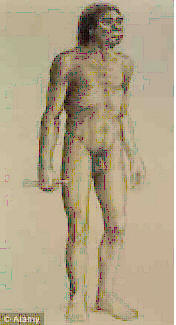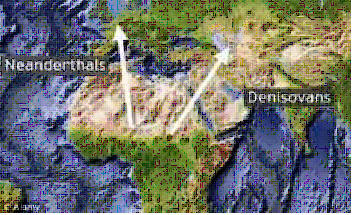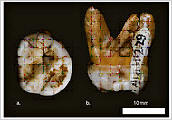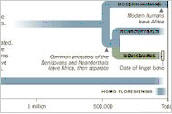 There Be Giants
There Be GiantsFiles for the July 2011 Bigfoot Central Show
Guest: Richard Substadt,
a DNA expert who has been working on alleged Sasquatch DNA.
Dennisovan Giants
 There Be Giants
There Be Giants
Archaeologists from the Russian Academy of Sciences, who excavated the site, discovered a rather strange tooth. It is bigger than any modern human tooth. And even stranger, it is also bigger than a Neanderthal tooth! It seems from this deduction, that this new breed were much larger than modern humans and their Neanderthal counterparts!
So is this the giant of myth and legend? Have we at last found real evidence of human like creatures that roamed the earth before and during mans first steps? More importantly, is this where we get our memories of giants roaming the earth, which in fact were even mentioned in the bible?
George Washington University Richmond, airs on the side of caution. They stated that: 'The tooth size isn't always a good indicator of body size. A Hominin can have big teeth and not be a giant'.
 Denisova
Cave Entrance
Denisova
Cave Entrance
It seems that we won't know for at least a while whether it really is a completely separate species, or a branch of modern man. At the moment scientists seem to be leaning towards the separate species idea. Just because the DNA is similar to modern humans, doesn't mean that we did interbreed with them. We shall have to wait and see. Their theory is that if they are a seperate species then modern man could not have mated and produced children. But are we certain of that? If the genetics are similar, then surely there is a possibility that we could.
Archaeology and science have a long way to go to figure out exactly how modern man evolved, and who we are related to.
From the depths of time, prehistoric man still holds it's secrets. How many more amazing discoveries will we find?.

Dennisovan New York Times
 An
international team of scientists has identified a previously shadowy human group
known as the Denisovans as cousins to Neanderthals who lived in Asia from
roughly 400,000 to 50,000 years ago and interbred with the ancestors of today’s
inhabitants of New Guinea.
An
international team of scientists has identified a previously shadowy human group
known as the Denisovans as cousins to Neanderthals who lived in Asia from
roughly 400,000 to 50,000 years ago and interbred with the ancestors of today’s
inhabitants of New Guinea.
The entire genome of the Denisovans was extracted from a tooth and finger bone.
 Traces
of Ancient DNA
Traces
of Ancient DNAGet Science News From The New York Times »
All the Denisovans have left behind are a broken finger bone and a wisdom tooth in a Siberian cave. But the scientists have succeeded in extracting the entire genome of the Denisovans from these scant remains. An analysis of this ancient DNA, published on Wednesday in Nature, reveals that the genomes of people from New Guinea contain 4.8 percent Denisovan DNA.
An earlier, incomplete analysis of Denisovan DNA had placed the group as more distant from both Neanderthals and humans. On the basis of the new findings, the scientists propose that the ancestors of Neanderthals and Denisovans emerged from Africa half a million years ago. The Neanderthals spread westward, settling in the Near East and Europe. The Denisovans headed east. Some 50,000 years ago, they interbred with humans expanding from Africa along the coast of South Asia, bequeathing some of their DNA to them.
“It’s an incredibly exciting finding,” said Carlos Bustamante, a Stanford University geneticist who was not involved in the research.
The research was led by Svante Paabo, a geneticist at the Max Planck Institute for Evolutionary Anthropology in Liepzig, Germany. Dr. Paabo and his colleagues have pioneered methods for rescuing fragments of ancient DNA from fossils and stitching them together. In May, for example, they published a complete Neanderthal genome.
The stocky, barrel-chested Neanderthals left a fossil record stretching from about 240,000 to 30,000 years ago in Europe, the Near East and Russia. Analyzing the Neanderthal genome, Dr. Paabo and his colleagues concluded that humans and Neanderthals descended from common ancestors that lived 600,000 years ago.
But the scientists also found that 2.5 percent of the Neanderthal genome is more similar to the DNA of living Europeans and Asians than to African DNA. From this evidence they concluded that Neanderthals interbred with humans soon after they emerged from Africa roughly 50,000 years ago.
Dr. Paabo’s success with European Neanderthal fossils inspired him and his colleagues to look farther afield. They began to work with Anatoli Derevianko of the Russian Academy of Sciences, who explores Siberian caves in search of fossils of hominins (species more closely related to living humans than to chimpanzees, our closest living relatives).
Last year, Dr. Derevianko and his colleagues sent Dr. Paabo a nondescript fragment of a finger bone from a cave called Denisova. Dr. Derevianko thought that the fossil, which is at least 50,000 years old, might have belonged to one of the earliest humans to live in Siberia.
Dr. Paabo and his colleagues isolated a small bundle of DNA from the bone’s mitochondria, the energy-generating structures within our cells. Dr. Paabo and his colleagues were surprised to discover that the Denisova DNA was markedly different from that of either humans or Neanderthals. “It was a great shock to us that it was distinct from those groups,” Dr. Paabo said in an interview.
Dr. Paabo and his colleagues immediately set about to collect all the DNA in the Denisova finger bone. Once they had sequenced its genome, they sent the data to researchers at Harvard Medical School and the Broad Institute in Cambridge, Mass., to compare with other species.
The Massachusetts scientists concluded that the finger bone belonged to a hominin branch that split from the ancestors of Neanderthals roughly 400,000 years ago. Dr. Paabo and his colleagues have named this lineage the Denisovans.
Next, the researchers looked for evidence of interbreeding. Nick Patterson, a Broad Institute geneticist, compared the Denisovan genome to the complete genomes of five people, from South Africa, Nigeria, China, France and Papua New Guinea. To his astonishment, a sizable chunk of the Denisova genome resembled parts of the New Guinea DNA.
“The correct reaction when you get a surprising result is, ‘What am I doing wrong?’ ” said Dr. Patterson. To see if the result was an error, he and his colleagues sequenced the genomes of seven more people, including another individual from New Guinea and one from the neighboring island of Bougainville. But even in the new analysis, the Denisovan DNA still turned up in the New Guinea and Bougainville genomes.
If the Denisovans did indeed have a range spreading from Siberia to South Asia, they must have been a remarkably successful kind of human. And yet, despite having the entire genome of a Denisovan, Dr. Paabo cannot say much yet about what they were like. “By sequencing my complete genome, there’s very little you could predict about what I look like or how I behave,” he said.
One solid clue to what the Denisovans looked like emerged in January. Dr. Paabo and his team had flown to Novosibirsk to share their initial results with Dr. Derevianko. Dr. Derevianko then presented them with a wisdom tooth from Denisova.
Bence Viola, a paleoanthropologist in the Department of Human Evolution at the Max Planck Institute of Evolutionary Anthropology, who was at the meeting, was flummoxed. “I looked at it and said, ‘Ah, O.K., this is not a modern human, and it’s definitely not a Neanderthal,”’ said Dr. Viola. “It was just so clear.”
The tooth had oddly bulging sides, for one thing, and for another, its large roots flared out to the sides. Back in Germany, Dr. Paabo and his colleagues managed to extract some mitochondrial DNA from the tooth. It proved to be a nearly perfect match to that of the Denisova finger bone.
That match offers some hope that if researchers can find the same kind of tooth on a fossil skull, or perhaps even a complete skeleton, they’ll be able to see what these ghostly cousins and ancestors looked like in real life.
Dr. Bustamante also thinks that other cases of interbreeding are yet to be discovered. “There’s a lot of possibility out there,” he said. “But the only way to get at them is to sequence more of these ancient genomes.”

Homo heidelbergensis
From Wikipedia, the free encyclopedia
|
Homo heidelbergensis |
|
|
|
|
| Kingdom: | Animalia |
| Phylum: | Chordata |
| Class: | Mammalia |
| Order: | Primates |
| Family: | Hominidae |
| Subfamily: | Homininae |
| Tribe: | Hominini |
| Subtribe: | Hominina |
| Genus: | Homo |
| Species: | H. heidelbergensis |
|
Homo heidelbergensis |
|
Homo heidelbergensis ("Heidelberg Man", named after the University of Heidelberg) is an extinct species of the genus Homo which may be[1] the direct ancestor of both Homo neanderthalensis in Europe and Homo sapiens.[2] The best evidence found for these hominin date between 600,000 and 400,000 years ago. H. heidelbergensis stone tool technology was very close to that of the Acheulean tools used by Homo erectus.
Contents[hide] |

Reconstruction of Homo heidelbergensis
Both H. antecessor and H. heidelbergensis are likely to be descended from the morphologically very similar Homo ergaster from Africa. But because H. heidelbergensis had a larger brain-case — with a typical cranial volume of 1100–1400 cm³ overlapping the 1350 cm³ average of modern humans — and had more advanced tools and behavior, it has been given a separate species classification. The species was tall, 1.8 m (6 ft) on average, and more muscular than modern humans. According to Professor Lee R. Berger of the University of Witwatersrand, numerous fossil bones indicate some populations of Heidelbergensis were "giants" routinely over 2.13 m (7 ft) tall and inhabited South Africa between 0.5 million and 300,000 years ago.[3]
In theory recent findings in Atapuerca (Spain) also suggest that H. heidelbergensis may have been the first species of the Homo genus to bury their dead, even offering gifts.
Some experts[4] believe that H. heidelbergensis, like its descendant H. neanderthalensis, acquired a primitive form of language. No forms of art or sophisticated artifacts other than stone tools have been uncovered, although red ochre, a mineral that can be used to create a red pigment which is useful as a paint, has been found at Terra Amata excavations in the south of France.
The morphology of the outer and middle ear suggests they had an auditory sensitivity similar to modern humans and very different from chimpanzees. They were probably able to differentiate between many different sounds.[5] Dental wear analysis suggests they were as likely to be right handed as modern people.[6]
H. heidelbergensis was a close relative (most probably a migratory descendant) of Homo ergaster. H. ergaster is thought to be the first hominin to vocalize[7] and that as H. heidelbergensis developed more sophisticated culture proceeded from this point.
A number of 400,000-year-old wooden projectile spears were found at Schöningen in northern Germany. These are thought to have been made by H. erectus or H. heidelbergensis. Generally, projectile weapons are more commonly associated with H. sapiens. The lack of projectile weaponry is an indication of different sustenance methods, rather than inferior technology or abilities. The situation is identical to that of native New Zealand Māori, modern H. sapiens, who also rarely threw objects, but used spears and clubs instead.[8]
 Divergent evolution
Divergent evolutionHomo heidelbergensis: Steinheim skull replica
Because of the radiation of H. heidelbergensis out of Africa and into Europe, the two populations were mostly isolated during the Wolstonian Stage and Ipswichian Stage, the last of the prolonged Quaternary glacial periods. Neanderthals diverged from H. heidelbergensis probably some 300,000 years ago in Europe, during the Wolstonian Stage; H. sapiens probably diverged between 200,000 and 100,000 years ago in Africa. Such fossils as the Atapuerca skull and the Kabwe skull bear witness to the two branches of the H. heidelbergensis tree.
Homo neanderthalensis retained most of the features of H. heidelbergensis after its divergent evolution. Though shorter, Neanderthals were more robust, had large brow-ridges, a slightly protruding face and lack of prominent chin. They also had a larger brain than all other hominins. Homo sapiens, on the other hand, have the smallest brows of any known hominin, are tall and lanky, and have a flat face with a protruding chin. H. sapiens have a larger brain than H. heidelbergensis, and a smaller brain than H. neanderthalensis, on average. To date, H. sapiens is the only known hominin with a high forehead, flat face, and thin, flat brows.
Some believe that H. heidelbergensis is a distinct species, and some that it is a cladistic ancestor to other Homo forms sometimes improperly linked to distinct species in terms of populational genetics.
Some scenarios of survival include
H heidelbergensis > H. neanderthalensis
H. heidelbergensis > H. rhodesiensis > H. sapiens idaltu > H sapiens sapiens
Those supporting a multiregional origin of modern humans envision fertile reproduction between many evolutionary stages and homo walking,[9] or gene transfer between adjacent populations due to gene passage and spreading in successive generations.
 Discovery
Discovery
Replica of the type specimen from Mauer
The first fossil discovery of this species was made on October 21, 1907, and came from Mauer where the workman Daniel Hartmann spotted a jaw in a sandpit. The jaw (Mauer 1) was in good condition except for the missing premolar teeth, which were eventually found near the jaw. The workman gave it to Professor Otto Schoetensack from the University of Heidelberg, who identified and named the fossil.
The next H. heidelbergensis remains were found in Steinheim an der Murr, Germany (the Steinheim Skull, 350kya); Arago, France (Arago 21); Petralona, Greece; and Ciampate del Diavolo, Italy.
In 1994 British scientists unearthed a lower hominin tibia bone just a few miles away from the English Channel, along with hundreds of ancient hand axes, at the Boxgrove Quarry site. A partial leg bone is dated to between 478,000 and 524,000 years old. H. heidelbergensis was the early proto-human species that occupied both France and Great Britain at that time; both locales were connected by a landmass during that epoch. Prior to Gran Dolina, Boxgrove offered the earliest hominid occupants in Europe.
The tibia had been gnawed by a large carnivore, suggesting that he had been killed by a lion or wolf or that his unburied corpse had been scavenged after death.[10]
Beginning in 1992, a Spanish team has located more than 5,500 human bones dated to an age of at least 350,000 years in the Sima de los Huesos site in the Sierra de Atapuerca in northern Spain. The pit contains fossils of perhaps 28 individuals together with remains of Ursus deningeri and other carnivores and a biface called Excalibur. It is hypothesized that this Acheulean axe made of red quartzite was some kind of ritual offering for a funeral. Ninety percent of the known H. heidelbergensis remains have been obtained from this site. The fossil pit bones include:
A complete cranium (Skull 5), nicknamed Miguelón, and fragments of other craniums, such as Skull 4, nicknamed Agamenón and skull 6, nicknamed Rui (from El Cid, a local hero).
A complete pelvis (Pelvis 1), nicknamed Elvis, in remembrance of Elvis Presley.
Mandibles, teeth, and many postcranial bones (femurs, hand and foot bones, vertebrae, ribs, etc.)
Indeed, nearby sites contain the only known and controversial Homo antecessor fossils.
In 2005 flint tools and teeth from the water vole Mimomys Savini, a key dating species, were found in the cliffs at Pakefield near Lowestoft in Suffolk. This suggests that hominins can be dated in England to 700,000 years ago, potentially a cross between Homo Antecessor and Homo Heidelbergensis

Another artist interpretation of the Denisovan man, compared to Patty of the Patterson Film.


